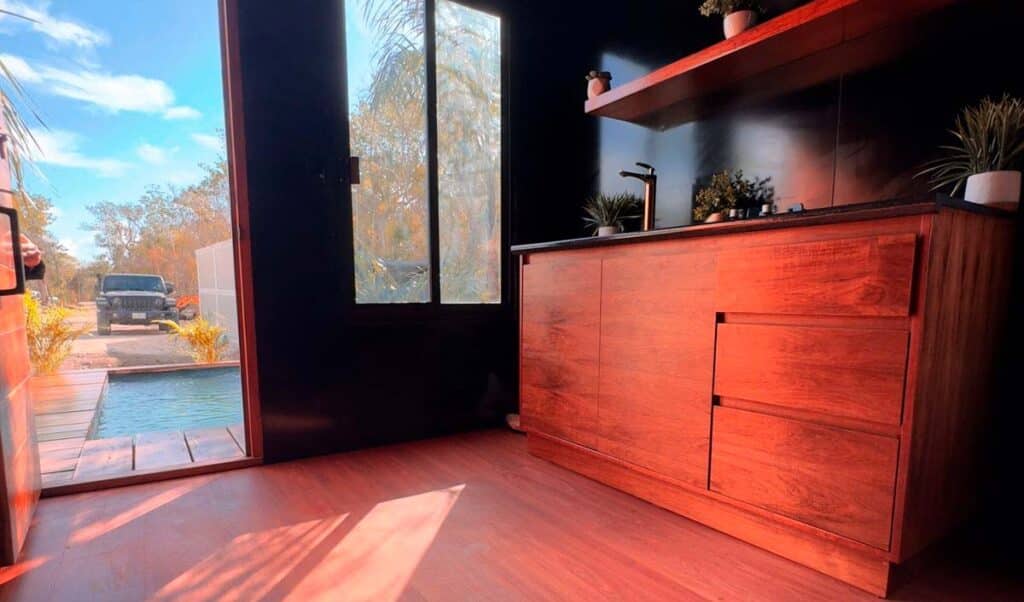What Are Container Modular Homes and How Do They Work?
Modular container homes are residences built from repurposed steel shipping containers. Each container is adapted, insulated, and outfitted to become a modern, livable space. Thanks to their standard shape, these modules can be stacked or joined in various configurations, allowing for single- or multi-level homes depending on the need. Reusing large metal structures also prevents the production of new materials and reduces the carbon footprint compared to traditional construction. In short, it’s an architectural innovation that merges container recycling with modular design to create versatile and sustainable housing.
Efficiency, Flexible Design, and Cost Savings
One of the main advantages of using containers is their flexibility in design. Each standard container can be cut and assembled in multiple ways, enabling creative and functional layouts. They can be stacked to create multi-level homes, incorporate rooftop terraces, or be connected to form open and well-lit interiors. This modular design also speeds up and simplifies the construction process: as enclosed steel structures, containers offer a strong frame resistant to extreme conditions.
- Fast construction: As prefabricated modules, on-site assembly is very fast. Time savings of up to 75% have been reported compared to traditional building methods. This lowers labor costs and speeds up delivery.
- Cost reduction: Using second-hand containers significantly reduces the need for basic construction materials (cement, new steel, etc.). With a simplified building process, the total budget is lower than with conventional methods.
- Scalability: It’s easy to expand or reconfigure the home by adding more containers as needed. This modularity allows incremental growth without major construction work.
- Structural strength: Containers are designed to withstand loads and harsh marine conditions, making the resulting homes highly durable. In earthquake- or hurricane-prone areas (like Quintana Roo), they offer added safety compared to fragile structures.
Taken together, these features make modular container homes cost-effective, safe, and easy to customize.
Use in Quintana Roo: Eco-Living and Sustainable Tourism
In the Yucatán Peninsula, especially in Quintana Roo, interest in sustainable tourism and the eco-living lifestyle has boosted the adoption of modular homes. In this tropical region with high tourist activity, container homes offer flexible lodging that blends well with the natural surroundings. They’ve been promoted both as eco-friendly residences and as alternative accommodations (eco-lodges, glamping, etc.) along the Riviera Maya. Their sturdy steel structure provides protection against hurricanes and earthquakes—common in the Mexican Caribbean. These homes also align with the region’s green philosophy: they reuse decommissioned containers instead of generating waste and use materials designed to minimize soil impact. In short, recycled containers meet Quintana Roo’s demand for affordable, eco-conscious housing that supports responsible tourism.
Environmental Benefits of Recycling Containers
The main environmental benefit of these homes is their use of metal containers that have reached the end of their life in maritime transport. Instead of abandoning or scrapping these massive steel units (which consumes lots of energy and produces waste), they’re given a new purpose. This avoids the pollution associated with melting down or discarding steel. For example, reusing a container instead of demolishing it saves the resources needed to build an equivalent home from scratch. In addition, using these existing structures reduces the need for new cement and steel, significantly lowering CO₂ emissions related to construction. In practice, this means less construction waste and reduced environmental degradation. Thus, building with recycled containers fosters a circular economy: it utilizes materials already available and avoids extracting new raw materials.
Sustainability Statistics in Construction
- Construction sector: uses nearly 50% of the world’s natural resources and contributes around 37% of global greenhouse gas emissions. Much of this impact comes from producing cement, steel, and other materials.
- Container availability: around 6 million containers move through Mexico annually and can be repurposed for housing. Globally, about 14 million unused containers are available for creative housing projects.
- Growing market: the global container housing market was valued at USD 61.83 billion in 2023 and is projected to reach USD 108.70 billion by 2032. This growth reflects the rising demand for affordable and eco-friendly housing solutions worldwide.
These figures support the relevance of recycled modular housing: reusing a container dramatically reduces the environmental footprint of a home while addressing the urgent need for sustainable construction.
The Eco-Living Trend: Adaptability and a Sustainable Future
Container homes are booming thanks to their low environmental impact, high adaptability, and affordable cost. This construction model is now widely recognized as “gaining global popularity” as a sustainable lifestyle option. Today, they are seen as an innovative solution aligned with eco-living, offering affordable, modular, and environmentally conscious housing. For investors and consumers, they represent a profitable trend: the use of recycled materials contributes to both economic and environmental efficiency. Ultimately, modular container housing combines sustainability and versatility, setting a precedent for greener, future-ready construction.
Conclusion
Modular homes made from recycled containers represent a smart and sustainable solution to the current challenges in construction. They not only offer significant savings in time and costs but also reduce environmental impact by giving a second useful life to metal structures that would otherwise end up as scrap. In regions like Quintana Roo, where urban development grows alongside ecological awareness, this type of housing perfectly integrates with eco-living lifestyles and responsible tourism initiatives.
For those looking to invest consciously or live in harmony with the environment, container homes are not just a trend but a real and sustainable response to the future of housing.


